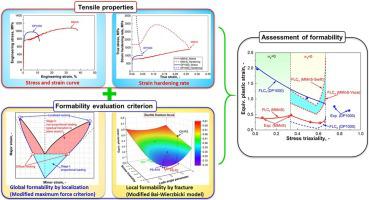Journal of Materials Processing Technology ( IF 6.7 ) Pub Date : 2021-09-08 , DOI: 10.1016/j.jmatprotec.2021.117368 Fuhui Shen 1 , Hesong Wang 1, 2 , Zhongjian Liu 1 , Wenqi Liu 3 , Markus Könemann 1 , Guo Yuan 2 , Guodong Wang 2 , Sebastian Münstermann 1 , Junhe Lian 3

|
Global formability and local formability are critical in different metal forming processes. Edge cracking, controlled by the local formability, is a dominant factor limiting the application of advanced high strength steels (AHSS) in automotive industries. The local formability of a medium-Mn steel (MMnS), a promising candidate of the third generation of AHSS, is evaluated based on forming limit curves at fracture and compared with a dual-phase DP1000 steel using the damage mechanics approach. The superior tensile properties of the investigated MMnS, high tensile strength, pronounced strain hardening, large uniform and total elongation, lead to a very good global formability, which is an indicator of necking resistance. However, the local formability of the investigated MMnS, which is an indicator of fracture resistance and quantified by the plastic strain at fracture under different stress states, is worse than the DP1000 steel. By comparing the local and global formability of the two AHSS, it is confirmed that ductile fracture is the dominant failure mode in the MMnS and the onset of localized necking occurs prior to ductile fracture in the DP1000 steel. To achieve an accurate determination of the local formability, the effects of stress states need to be considered, which cannot be derived explicitly from uniaxial tensile tests. In addition to tensile properties, more attention should be paid to the local formability of new AHSS to assess their potential application in automotive industries.
中文翻译:

中锰钢的局部成形性
整体成形性和局部成形性在不同的金属成形工艺中至关重要。受局部成形性控制的边缘开裂是限制先进高强度钢 (AHSS) 在汽车工业中应用的主要因素。中锰钢 (MMnS) 的局部成形性是第三代高强度钢的有希望的候选者,基于断裂成形极限曲线进行评估,并使用损伤力学方法与双相 DP1000 钢进行比较。所研究的 MMnS 优异的拉伸性能、高拉伸强度、显着的应变硬化、大的均匀伸长率和总伸长率,导致非常好的整体成形性,这是抗颈缩性的指标。然而,所研究的 MMnS 的局部可成形性,这是抗断裂性的指标,由不同应力状态下断裂时的塑性应变量化,比 DP1000 钢差。通过比较两种 AHSS 的局部和整体可成形性,确认韧性断裂是 MMnS 中的主要失效模式,并且局部颈缩发生在 DP1000 钢的韧性断裂之前。为了准确确定局部可成形性,需要考虑应力状态的影响,这不能从单轴拉伸试验中明确得出。除了拉伸性能外,还应更多关注新型高强钢的局部成形性,以评估其在汽车行业的潜在应用。通过比较两种 AHSS 的局部和整体可成形性,确认韧性断裂是 MMnS 中的主要失效模式,并且局部颈缩的开始发生在 DP1000 钢的韧性断裂之前。为了准确确定局部可成形性,需要考虑应力状态的影响,这不能从单轴拉伸试验中明确得出。除了拉伸性能外,还应更多关注新型高强钢的局部成形性,以评估其在汽车行业的潜在应用。通过比较两种 AHSS 的局部和整体可成形性,确认韧性断裂是 MMnS 中的主要失效模式,并且局部颈缩的开始发生在 DP1000 钢的韧性断裂之前。为了准确确定局部可成形性,需要考虑应力状态的影响,这不能从单轴拉伸试验中明确得出。除了拉伸性能外,还应更多关注新型高强钢的局部成形性,以评估其在汽车行业的潜在应用。需要考虑应力状态的影响,这不能从单轴拉伸试验中明确得出。除了拉伸性能外,还应更多关注新型高强钢的局部成形性,以评估其在汽车行业的潜在应用。需要考虑应力状态的影响,这不能从单轴拉伸试验中明确得出。除了拉伸性能外,还应更多关注新型高强钢的局部成形性,以评估其在汽车行业的潜在应用。











































 京公网安备 11010802027423号
京公网安备 11010802027423号